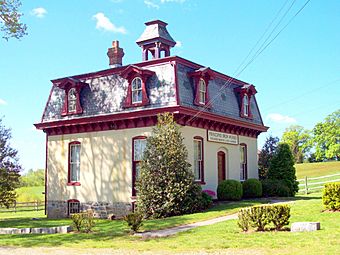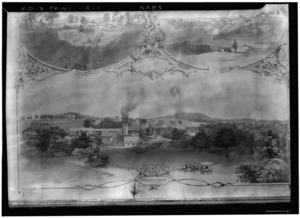Principio Furnace facts for kids
Quick facts for kids |
|
|
Principio Furnace
|
|

Principio Furnace Office Structure, April 2010
|
|
| Nearest city | Perryville, Maryland |
|---|---|
| Area | 185 acres (75 ha) |
| NRHP reference No. | 72000575 |
| Added to NRHP | February 11, 1972 |
The Principio Furnace and its village are located in Cecil County, Maryland. It's about 4 miles (6.4 km) northeast of Havre de Grace, Maryland. This place was once a very important iron-making center in early America.
Contents
A Look Back: The History of Principio Furnace
Starting the Ironworks
The Principio Iron Works began in 1719. A man named Joseph Farmer started it with money from Britain. An expert ironmaker, John England, helped make it a big success. By the 1740s, it was one of the best ironworks in the American colonies. They made "pig iron," which is a basic form of iron, and sold it in London.
During the American Revolution, another ironmaster named Thomas Russell, Jr. took over. He helped the American soldiers by making cannonballs for the Continental Army.
The Larger Principio Company
The ironworks in Maryland were part of a bigger business called the Principio Company. This company also owned other properties, including the Accokeek or Potomac Ironworks. This other ironworks was on land that belonged to Augustine Washington, who was George Washington's father.
The Accokeek works were first used to find iron ore. By 1726, it might have had a "cold blast charcoal furnace." This is a special type of oven used to melt iron. The Accokeek site was the main office for the Principio Company for a while. It closed down in the mid-1750s.
Destruction and Rebuilding
Sadly, the ironworks in Maryland were destroyed by the British army in 1813. This happened during the War of 1812.
But the story didn't end there! In 1836, the ruined site was bought by Joseph Whitaker and his brothers. They also had partners like Thomas Garrett, who was famous for helping enslaved people escape to freedom. Another partner was William Chandler.
The site still had water power, which was important for running machinery. Even better, new railroad tracks were laid right through the property. This was the Philadelphia, Wilmington, and Baltimore Railroad. William Chandler was actually a director of this railroad company.
The new owners rebuilt the ironworks. They opened a new blast furnace in 1837. They kept making improvements over many years.
Later Years and Legacy
Before the American Civil War, the Whitaker family split their businesses. Joseph Whitaker took the properties in Pennsylvania. George Price Whitaker took the ones in Maryland and Virginia.
George Price Whitaker and his family continued to work in the iron and steel business. Their companies eventually became part of a larger company called Wheeling Steel Company in 1921. This company later became Wheeling-Pittsburgh Steel.
The Principio Furnace made iron until 1925. Today, part of the old stone furnace still stands at the site. In 1972, Principio Furnace was added to the National Register of Historic Places. This means it's an important historical site that should be protected.
Gallery
- Remnants of the Principio Furnace
-
The old bloomery, depicted in 1936










